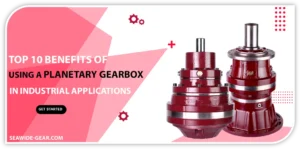Top 10 Benefits of Using a Planetary Gearbox in Industrial Applications

Introduction: Why Gearboxes Are Essential in Modern Industry
A planetary gearbox (also known as an epicyclic gear train) is a compact mechanical transmission system where one or more planet gears revolve around a central sun gear and mesh with a surrounding ring gear. This design provides high torque density, exceptional load distribution, and efficiency ranging from 95% to 98%, making it ideal for demanding industrial applications such as steel rolling mills, wind turbines, and marine propulsion.
In today’s highly specialized industrial landscape, gearboxes serve as the backbone of mechanical power transmission. They play a crucial role in converting energy from motors into usable torque for demanding tasks. The planetary gearbox, also known as the sun & planetary gear reducer, has emerged as a leader among gearbox types due to its exceptional balance between compact size, high torque output, and durability. These systems are engineered to be robust, efficient, and capable of handling the rigorous demands of continuous operation in a vast array of industrial settings.
Planetary gearboxes are now a standard component in sectors such as steel manufacturing, cement production, mining operations, petrochemical plants, wind energy systems, and marine applications. Their inherent design allows for a remarkable combination of characteristics that are often difficult to achieve with other gearbox configurations. The unique configuration of planetary gear systems delivers consistent performance, high efficiency, and remarkable longevity — making them indispensable in modern industry. From the immense forces at play in a steel rolling mill to the precise movements required in robotics, planetary gearboxes provide the crucial mechanical advantage and control that modern machinery demands.
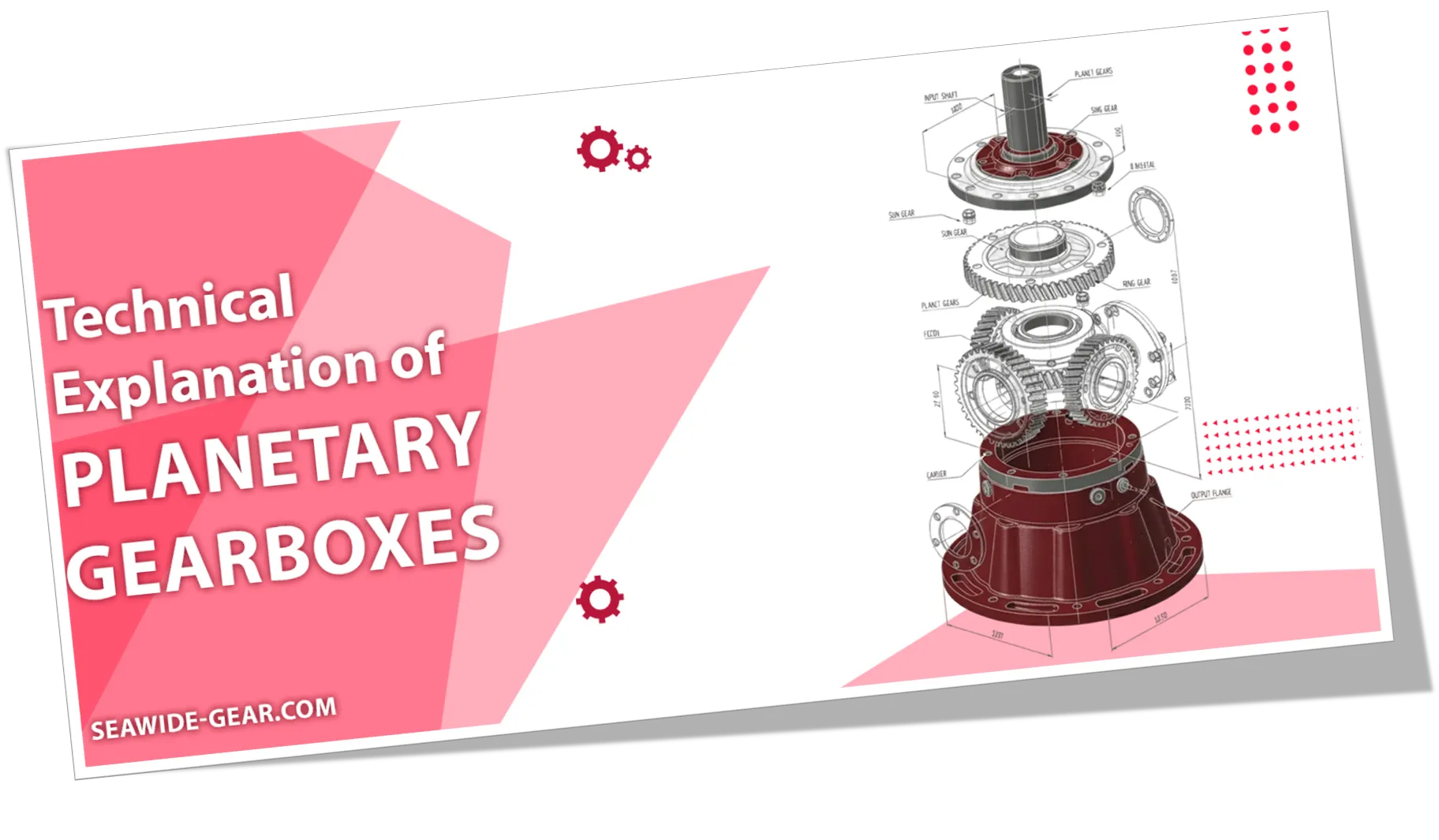
Technical Explanation of Planetary Gearboxes & Benefits of Using a Planetary Gearbox
Design and Components
A planetary gearbox is a marvel of mechanical engineering, characterized by its compact and efficient design. Its core functionality relies on a specific arrangement of gears that, as the name suggests, mimics the orbital motion of planets around a sun. The primary components are:
- Sun Gear: This gear is situated at the very center of the planetary system. It acts as the input or output shaft, depending on the configuration, and is responsible for driving the planetary gears. The sun gear typically has external teeth.
- Planet Gears: These gears are the “planets” in the system. They are mounted on a carrier and orbit around the sun gear. Each planet gear meshes with both the sun gear and the ring gear. They are crucial for load distribution and torque multiplication. The number of planet gears can vary, commonly ranging from three to five, to further enhance load-sharing and stability.
- Ring Gear (Annulus): This is the outermost gear, forming a cylindrical casing for the planetary gear set. It has internal teeth that mesh with the external teeth of the planet gears. The ring gear serves as the stationary element or the output element in many configurations.
Click here to view our planetary gearbox products and their technical information.
Additional Components:
- Carrier: This component connects the planet gears and ensures they maintain their relative positions as they orbit the sun gear. It is typically the element that rotates, carrying the planet gears with it. The carrier can also serve as the input or output shaft.
- Bearings: High-quality bearings are integrated to support the rotating shafts and gears, minimizing friction and ensuring smooth, efficient operation. These are critical for the longevity and performance of the gearbox.
- Shafts and Housings: Input and output shafts connect the gearbox to the prime mover (e.g., motor) and the driven load, respectively. The housing provides structural integrity, protects the internal components, and ensures proper lubrication.
Materials:
High-grade steel alloys, such as hardened and tempered alloy steels, are typically used for the construction of the gears and critical components. These materials are chosen for their exceptional wear resistance, high tensile strength, and fatigue life, which are essential for withstanding the immense forces and continuous operation found in industrial applications. Surface treatments like nitriding or case hardening are often applied to further enhance durability and lifespan.
Advantages Over Other Gearbox Types
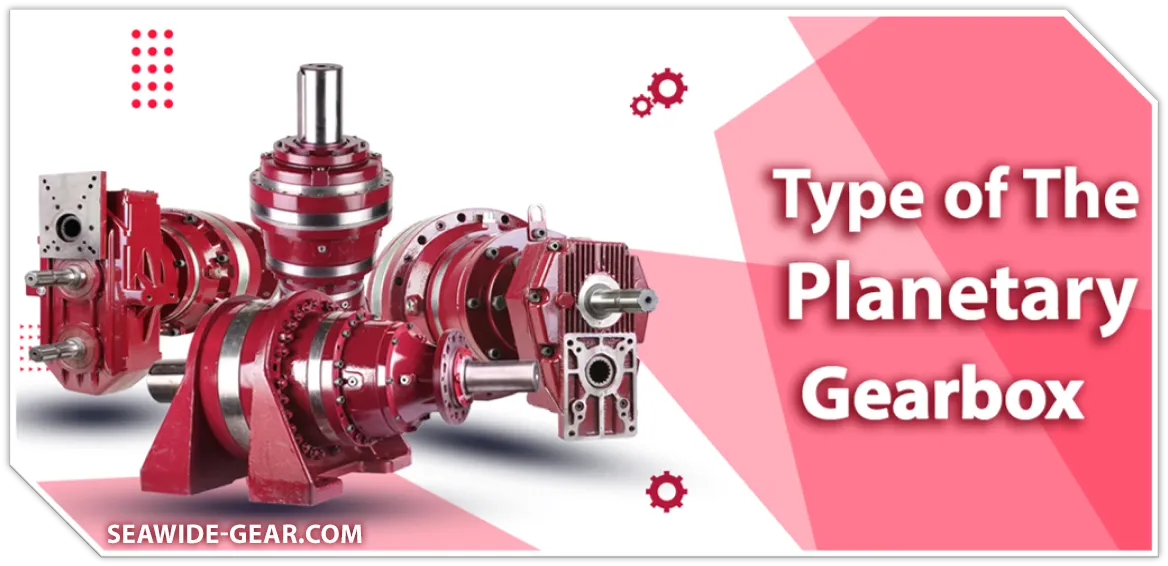
Compared to more conventional gearbox types like parallel shaft gearboxes (helical, spur) or worm gear reducers, planetary gearboxes offer a distinct set of advantages that make them the preferred choice for many demanding industrial applications:
- Higher Torque Density (Torque per Unit Volume): This is perhaps the most significant advantage. The unique geometry allows for multiple teeth to be engaged simultaneously between the sun, planet, and ring gears. This distributes the torque across a larger surface area, enabling planetary gearboxes to transmit much higher torques within a smaller physical volume compared to other gearbox types of equivalent power rating. This is crucial for applications where space is limited.
- Superior Load Distribution: As mentioned, the simultaneous engagement of multiple planet gears with both the sun and ring gears means the load is shared across many teeth. In contrast, a parallel shaft gearbox typically has only one or two sets of teeth transmitting the entire load between meshing gears. This even distribution drastically reduces localized stress, leading to less wear and tear and a longer operational life.
- Compact Footprint: The coaxial input and output shafts, inherent in the planetary design (the sun gear and carrier often rotate about the same axis), result in a much more compact and cylindrical form factor. This is a significant advantage in applications with tight space constraints, such as within the nacelle of a wind turbine or in the confined spaces of robotic arms.
- Lower Backlash for Precision Applications: Many planetary gearboxes can be designed with very low backlash, which is the angular play between the input and output shafts when the direction of rotation is reversed. This precision is critical for applications requiring accurate positioning and speed control, such as in robotics, automated machinery, and CNC equipment where even small errors in movement can be detrimental. While traditional gearboxes can also achieve low backlash, planetary designs often achieve it more inherently and with greater rigidity.
- High Rotational Speed Capability: Planetary gearboxes can efficiently handle very high input speeds. The design allows for the planet gears to rotate at speeds higher than the sun gear, and the carrier can also achieve high speeds. This makes them well-suited for applications driven by high-speed electric motors, such as in wind turbines.
- Higher Stiffness: Due to the multiple gear engagements and the overall structural integrity of the design, planetary gearboxes tend to be stiffer than other types, resisting deflection under load. This contributes to their precision and durability.
Click here to view our planetary gearbox products and their technical information.
Benefits of Using a Planetary
| Benefit | Key Points | Industrial Impact |
| High Torque Output | Load shared across multiple teeth, ideal for heavy-duty machinery | Crushers, rolling mills |
| Compact Design | Coaxial input/output shafts minimize size | Robotics, aerospace |
| Exceptional Efficiency | 95–98% efficiency, minimal frictional losses | Lower energy costs |
| Load Sharing Capability | Torque evenly distributed | Extended gear life |
| High Durability | Hardened steel alloys, shock-load resistance | Mining, steel plants |
| Precision Control | Low backlash for accurate positioning | CNC, robotics |
| Industry Versatility | Configurable for harsh or clean environments | Marine, mining |
| Energy Savings | Reduced motors/lower electricity bills | Sustainable operations |
| Low Maintenance | Long service intervals | Less downtime |
| Scalability & Customization | Wide size & ratio options | Tailored solutions |
Industrial Applications
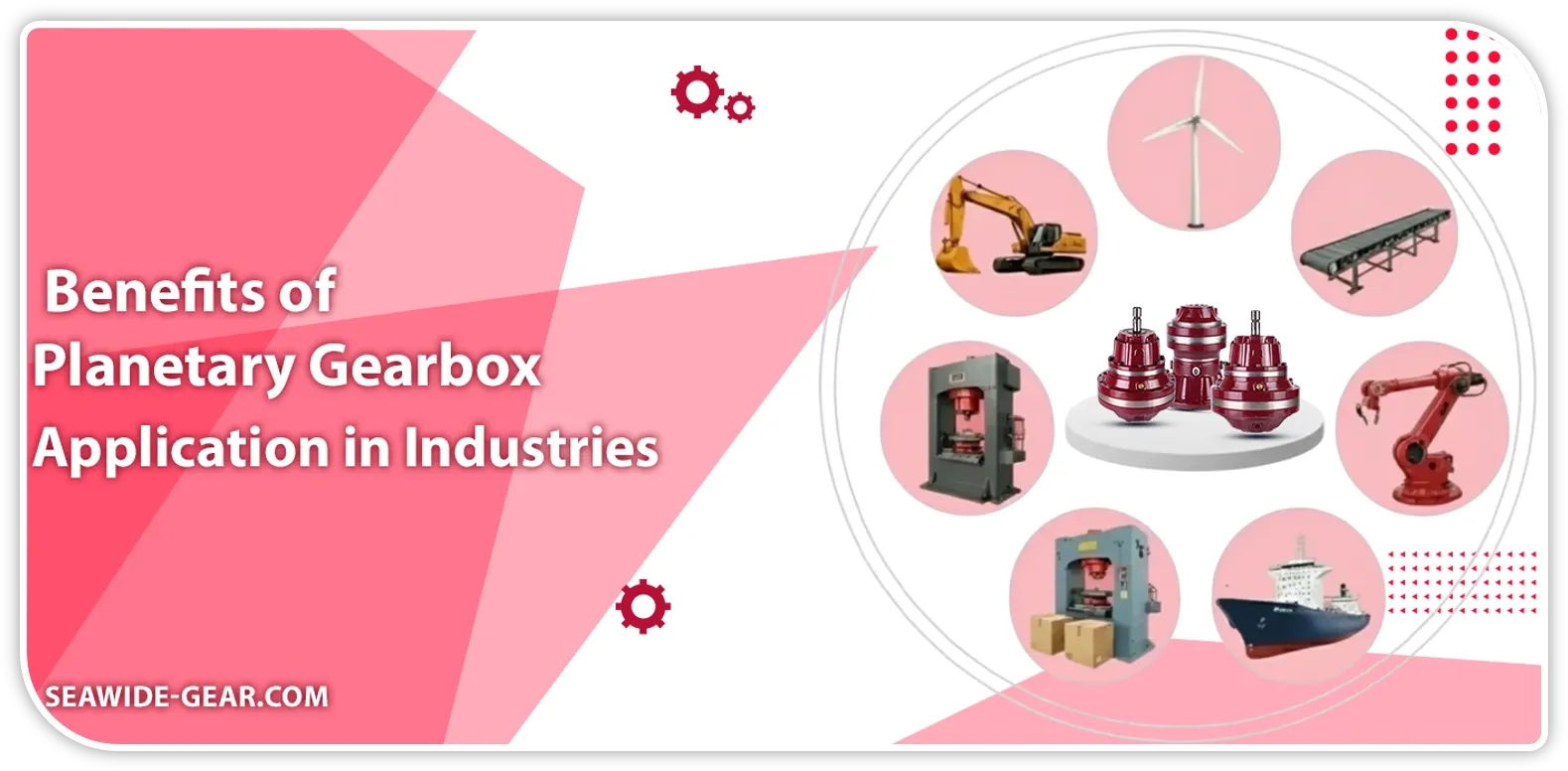
The versatility and robust performance of planetary gearboxes have made them integral to a wide range of heavy-duty industrial sectors. Their ability to handle extreme loads, maintain precision, and operate reliably in harsh environments makes them the preferred choice for critical machinery.
Steel Industry
In the steel industry, planetary gearboxes are indispensable for driving large-scale machinery that operates under immense loads and experiences frequent shock inputs. They are commonly found in:
- Rolling Mills: These are vital for shaping steel into various forms like sheets, bars, and beams. Planetary gearboxes provide the stable, high torque necessary to drive the heavy rollers. They can also absorb the significant shock loads that occur when billets of steel enter the rolling process, preventing damage to the drive system. Their ability to maintain precise speeds ensures consistent product quality.
- Cranes and Hoists: For lifting and moving massive steel components, planetary gearboxes offer the high torque and controlled lowering capabilities required for safe and efficient operation.
- Coil Handling Equipment: Driving systems for winding and unwinding heavy steel coils rely on the robust torque delivery of planetary gearboxes.
Cement Industry
The cement production process involves handling large volumes of abrasive materials and operating heavy machinery in dusty, demanding conditions. Planetary gearboxes are integral to:
- Rotary Kilns: These massive cylindrical furnaces rotate slowly to process raw materials into cement. Planetary gearboxes provide the exceptionally high and sustained torque required to turn the kiln, often under significant load variations due to material flow. They are designed to withstand the abrasive dust and high temperatures.
- Conveyors and Elevators: Moving raw materials and finished cement products across vast plant areas requires powerful and reliable drive systems. Planetary gearboxes on heavy-duty conveyors and bucket elevators ensure continuous operation even with full loads.
- Crushers and Grinding Mills: Breaking down raw materials into smaller particles requires immense torque. Planetary gearboxes are used in primary and secondary crushers and in ball or roller mills that grind clinker into cement powder.
Mining Operations
Mining environments are among the most challenging, characterized by extreme loads, abrasive dust, moisture, and continuous operation. Planetary gearboxes are a staple in:
- Crushers: Large jaw, cone, and impact crushers that break down ore and rock rely on the high torque density of planetary gearboxes.
- Conveyors: Belt conveyors that transport vast quantities of ore across open-pit mines or underground tunnels are driven by planetary gearboxes for their reliability and power.
- Grinding Mills (Ball Mills, SAG Mills): These mills are crucial for reducing the size of mined ore to facilitate mineral extraction. The sheer torque required to rotate these massive rotating drums makes planetary gearboxes an ideal solution.
- Excavators and Draglines: Planetary gearboxes are often used in the slew drives and travel drives of heavy mining equipment for their high torque and precise control.
Petrochemical Sector
Precision and reliability are paramount in petrochemical plants, where processes often involve hazardous materials and require continuous, controlled operation. Planetary gearboxes are utilized in:
- Mixers and Agitators: For blending chemicals, polymers, and other substances in reaction vessels and storage tanks, planetary gearboxes provide the consistent torque and speed control needed for efficient mixing.
- Pumps: High-pressure or high-viscosity pumps used for transferring crude oil, refined products, or chemical feedstocks often employ planetary gearboxes to achieve the required output torque from electric motors.
- Compressors: In gas compression applications, planetary gearboxes can be used to match the motor speed to the optimal operating speed of the compressor.
- Conveyor Systems: Moving raw materials or finished products within the plant.
Wind Energy
In the renewable energy sector, planetary gearboxes are critical components in wind turbines, enabling the efficient conversion of wind energy into electrical power.
- Wind Turbine Nacelles: The primary function of a planetary gearbox in a wind turbine is to multiply the slow, high-torque rotation of the rotor blades into the high speed required by the electrical generator. Typically, they are used in multi-stage configurations to achieve the necessary speed increase while maintaining high efficiency. Their compact design is essential for fitting within the confined space of the nacelle.
Marine Applications
The harsh, corrosive environment of the sea demands robust and reliable equipment. Planetary gearboxes are found in:
- Propulsion Systems: For smaller vessels or as part of a larger system, planetary gearboxes can be used to transfer power from engines to propellers, providing high torque and precise speed control.
- Winching and Towing Systems: Anchor winches, towing winches, and capstans on ships and offshore platforms require the immense torque and controlled operation provided by planetary gearboxes. Their sealed designs help protect against saltwater ingress.
- Deck Machinery: Other applications like cranes and elevators on vessels also benefit from the compact and powerful nature of planetary gearboxes.
Click here to view our planetary gearbox products and their technical information.
Top 10 Benefits of Using a Planetary Gearbox in Industrial Applications
The widespread adoption of planetary gearboxes across numerous demanding industries is a testament to their exceptional performance characteristics. Here are the top 10 benefits that make them a preferred choice for critical power transmission applications:
- High Torque Output
Planetary gearboxes are engineered to deliver exceptionally high torque densities. This means they can produce a greater amount of torque for their size compared to other gearbox types. This capability stems from the fundamental design principle where the load is distributed across multiple gear teeth simultaneously between the sun gear, planet gears, and ring gear. This multi-point contact significantly increases the effective torque transmission capacity, making them ideal for applications requiring immense power, such as in heavy machinery, crushers, and rolling mills. The formula for torque is generally ( \tau = F \times r ), where ( F ) is the force and ( r ) is the lever arm. By distributing the force ( F ) across multiple contact points and effectively utilizing larger radii in the gear train, higher overall ( \tau ) can be achieved.
- Compact & Space-Saving Design
The coaxial arrangement of the input and output shafts, a hallmark of planetary gearboxes, results in a remarkably compact and cylindrical form factor. The sun gear, planet gears, and carrier all rotate about a common axis. This design minimizes the overall volume and length of the gearbox, making it an excellent solution for applications where space is at a premium. This is particularly advantageous in industries like robotics, aerospace, and wind energy, where fitting powerful drive systems into confined spaces is a critical design constraint.
- Exceptional Efficiency
Planetary gearboxes are renowned for their high operational efficiency. Due to the balanced load distribution and the precision with which the gears mesh, frictional losses are minimized. Typical efficiencies for single-stage planetary gearboxes can range from ( 95% ) to ( 98% ). In multi-stage configurations, while overall efficiency decreases slightly with each stage, they still maintain a significant advantage over many other gearbox types. High efficiency translates directly to reduced energy consumption and lower operating costs over the lifespan of the equipment. The efficiency ( \eta ) is often expressed as the ratio of output power ( P_{out} ) to input power ( P_{in} ): ( \eta = \frac{P_{out}}{P_{in}} \times 100% ).
- Load Sharing Capability
As discussed in the technical explanation, the core of the planetary gearbox’s strength lies in its ability to share the load across multiple planet gears simultaneously. Each planet gear meshes with both the sun gear and the ring gear, meaning that the total input torque is distributed among several points of contact. This even distribution prevents excessive stress on any single gear tooth, thereby reducing wear, increasing the lifespan of the components, and enhancing the gearbox’s reliability under continuous and heavy operation.
- High Durability under Heavy Loads
The robust construction and the inherent load-sharing capability of planetary gearboxes make them exceptionally durable, even when subjected to extreme industrial stresses. They are specifically engineered to withstand shock loads, sudden torque reversals, and the rigors of continuous operation in demanding environments such as mining, steel manufacturing, and heavy construction. The use of hardened steel alloys and precision manufacturing further contributes to their resilience and longevity in high-stress applications.
Click here to view our planetary gearbox products and their technical information.
- Precision Control
Planetary gearboxes can be designed and manufactured with very low backlash, which is the small amount of free play between meshing gear teeth when the direction of rotation is reversed. This low backlash is critical for applications that require precise positioning and accurate speed regulation. Examples include robotic arms, automated assembly lines, and CNC machinery, where even minor deviations can lead to production errors. The rigid structure of the planetary gear set contributes to this inherent precision.
- Versatility Across Multiple Industries
The fundamental design of the planetary gearbox makes it incredibly adaptable to a wide range of applications and environments. Whether it’s the corrosive salt-laden air of maritime applications, the abrasive dust of mining, the high temperatures of industrial furnaces, or the sterile conditions of a cleanroom, planetary gearboxes can be configured and sealed to operate reliably. This versatility means that a single, proven technology can be employed across a broad spectrum of industrial needs, simplifying maintenance and spare parts management.
- Energy Savings
The exceptional efficiency (95-98%) of planetary gearboxes directly translates into significant energy savings. By minimizing power losses due to friction and inefficient gear meshing, a greater proportion of the input energy from the motor is converted into useful output work. Over the operational life of industrial machinery, these savings can amount to substantial reductions in electricity costs, contributing to a lower total cost of ownership and a more sustainable operation.
- Low Maintenance Requirements
The robust design, superior load distribution, and high-quality materials used in planetary gearboxes contribute to their exceptional durability and longevity. This, in turn, leads to extended service intervals and reduced maintenance requirements. Properly specified and maintained planetary gearboxes can operate for tens of thousands of hours with minimal intervention beyond routine lubrication checks. This minimizes downtime, reduces labor costs, and enhances overall operational productivity.
- Scalability & Customization
Planetary gearboxes offer remarkable scalability and can be customized to meet very specific application requirements. They can be manufactured in a wide range of sizes and torque capacities, from small, high-precision units for robotics to massive, high-torque units for heavy industry. Furthermore, they can be configured with multiple stages to achieve very high reduction ratios. Customization options extend to shaft configurations, mounting arrangements, sealing capabilities, and material choices, allowing engineers to tailor the gearbox precisely to the unique demands of their application.
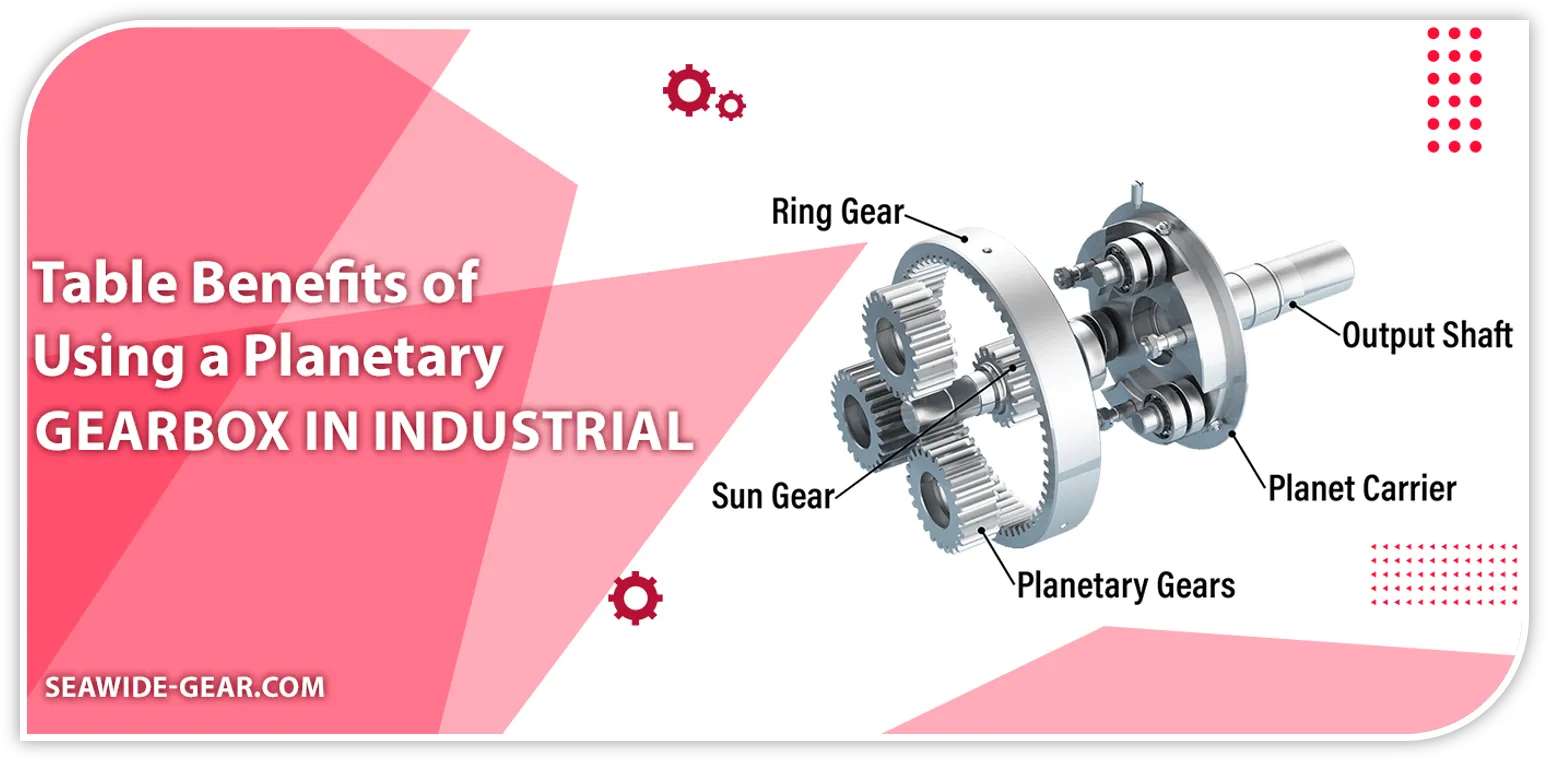
Expanded Competitive Comparison & Benefits of Using a Planetary Gearbox
| Manufacturer | Certifications | Customization | Global Support | Distinct Strengths |
| Seawide Gear | ISO 9001, AGMA | High – bespoke designs | Extensive network | Heavy-duty builds, tailored industrial solutions |
| Reggiana Riduttori | ISO 9001 | Medium – standard variants | Europe-focused | Reliable for agricultural equipment |
| Bonfiglioli | ISO 9001 | Medium | Global | Broad product range, affordable |
| Rossi | ISO 9001 | Low | Limited | Compact units for packaging industry |
| Brevini | ISO 9001 | Medium | Europe/Asia | Strong multi-stage planetary gearboxes |
Competitive Comparison & Benefits of Using a Planetary gearbox
The market for high-performance industrial gearboxes is competitive, with several established manufacturers offering quality products. While companies like Reggiana Riduttori, Bonfiglioli, Rossi, and Brevini are recognized for producing excellent planetary gearboxes, Seawide Gear distinguishes itself through a combination of factors that cater to specific industrial needs and offer enhanced value to customers.
Seawide’s commitment to quality is evident in its operations:
- ISO 9001-Certified Manufacturing: This certification ensures that Seawide adheres to stringent international standards for quality management systems throughout its design, manufacturing, and service processes, guaranteeing consistent product quality and reliability.
- AGMA-Standard Designs: Adherence to standards set by the American Gear Manufacturers Association (AGMA) signifies that Seawide’s gearboxes are designed and manufactured to meet rigorous performance and durability benchmarks, ensuring they can perform reliably in demanding industrial environments.
- Complete Customization Options for Niche Applications: While many manufacturers offer standard product lines, Seawide places a strong emphasis on providing bespoke solutions. This means they are adept at understanding unique application challenges and engineering custom planetary gearboxes that precisely match specific torque, speed, mounting, and environmental requirements, especially for niche or highly specialized industrial needs.
- Superior After-Sales Support and Global Reach: Beyond the initial sale, Seawide emphasizes building long-term customer relationships through dedicated technical support, prompt service, and readily available spare parts. Their global network ensures that customers can receive timely assistance and maintain their equipment efficiently, regardless of their location.
This focus on stringent quality control, adherence to industry best practices, deep customization capabilities, and comprehensive customer support allows Seawide Gear to stand out in a crowded market.
Click here to view our planetary gearbox products and their technical information.
Buying Guide: Selecting the Right Planetary Gearbox
Choosing the appropriate planetary gearbox is a critical decision that impacts the performance, efficiency, and longevity of your industrial machinery. A systematic approach ensures you select a unit that perfectly matches your application’s demands.
Step 1: Define Operational Requirements
This is the foundational step and requires a thorough understanding of how the gearbox will be used.
- Torque: Determine the peak torque, continuous torque, and transient torque requirements. This is often the most critical parameter and is usually specified in Newton-meters (Nm) or pound-feet (lb-ft).
- Speed Ratio (Gear Ratio): Calculate the required speed reduction or increase. This is the ratio of the input speed to the output speed. It’s important to consider both nominal and maximum/minimum speeds.
- Input Power: Understand the power output of your prime mover (e.g., electric motor, engine).
- Mounting Options: Consider how the gearbox will be attached to the machinery. Common options include foot mounting, flange mounting, or shaft mounting. The orientation (horizontal or vertical) is also important.
- Environmental Factors: Assess the operating environment. This includes temperature extremes, exposure to dust, moisture, chemicals, vibration levels, and any specific hygiene or explosion-proof requirements (ATEX).
Step 2: Evaluate Load Conditions
Understanding the nature of the load is crucial for selecting a gearbox that can withstand the stresses it will encounter.
- Types of Loads:
- Constant Torque: The torque requirement remains relatively steady throughout the operation (e.g., conveyor belts with uniform material).
- Intermittent Loads: Torque is applied periodically, with periods of no load or reduced load in between (e.g., batch processing mixers).
- Shock Loads: Sudden, high-magnitude torque spikes that occur during startup, shutdown, or during operation (e.g., crushers, rock drills, machines starting under load). Planetary gearboxes are generally well-suited to handle shock loads due to their inherent strength and load distribution.
- Duty Cycle: Determine whether the application involves continuous operation (24/7), frequent starts and stops, or intermittent use. This impacts the thermal capacity and fatigue life considerations.
Step 3: Consider Efficiency & Backlash
These parameters directly influence the precision and energy consumption of your system.
- Efficiency: For energy-intensive applications or where operational costs are a primary concern, prioritize gearboxes with higher efficiency ratings (closer to ( 98% )). A higher efficiency means less energy is wasted as heat, leading to lower electricity bills and potentially smaller motor sizes.
- Backlash: If your application requires precise positioning or controlled movement (e.g., robotics, automation, material handling systems where accuracy is paramount), select a gearbox with very low backlash. For applications where precise positioning is not critical, standard backlash might be acceptable and could be more cost-effective. Planetary gearboxes generally offer lower backlash than many other gearbox types.
Step 4: Plan for Maintenance & Service
Consider the long-term support and maintenance needs of the gearbox.
- Accessibility: Ensure the gearbox will be accessible for routine maintenance, such as lubrication checks and oil changes.
- Replacement Parts: Investigate the availability and lead times for spare parts. Choosing a manufacturer with a strong global presence and readily available parts can prevent prolonged downtime in case of unforeseen issues.
- Technical Support: Select a manufacturer that offers reliable technical support. Expert advice during selection and prompt assistance during operation can be invaluable.
By carefully following these steps, you can confidently select a planetary gearbox that will reliably and efficiently drive your industrial applications for years to come.
About Seawide
Seawide Gear is a globally recognized leader specializing in the design and manufacturing of high-performance planetary gear reducers for a wide array of industrial applications. With a deep understanding of the critical demands of modern industry, Seawide is dedicated to providing solutions that enhance efficiency, reliability, and productivity.
Our commitment to excellence is underpinned by our adherence to internationally recognized standards:
- ISO 9001: Our manufacturing processes are certified under ISO 9001, ensuring a consistent and high level of quality control across all stages of production, from design and development to manufacturing and customer service.
- AGMA: We design and produce our gearboxes in accordance with AGMA (American Gear Manufacturers Association) standards, guaranteeing that our products meet rigorous performance, durability, and safety benchmarks.
Seawide’s product portfolio is characterized by:
- Custom Design Solutions: We excel in developing tailor-made planetary gearboxes to meet the unique and often complex requirements of our clients’ specific applications. Our engineering team collaborates closely with customers to engineer optimal solutions.
- Heavy-Duty Performance for Tough Industries: Our gearboxes are built to withstand the most demanding operational environments, including those found in mining, steel production, cement manufacturing, and other heavy industries where reliability under extreme conditions is paramount.
- Extended Warranties and Dedicated Technical Support: We stand behind the quality of our products with comprehensive warranties and provide ongoing, dedicated technical support to ensure our customers receive the assistance they need throughout the lifecycle of their gearboxes.
Seawide Gear is more than just a supplier; we are a partner committed to delivering power transmission solutions that drive your success.
Click here to view our planetary gearbox products and their technical information.
Call to Action
Choosing the right gearbox is not merely a component selection; it is a strategic investment in the efficiency, productivity, and long-term profitability of your industrial operations. A well-specified planetary gearbox can reduce energy consumption, minimize downtime, and ensure consistent performance under the most demanding conditions.
Don’t leave your critical power transmission needs to chance.
Contact Seawide Gear today to leverage our expertise and secure a solution that optimizes your plant’s performance. Our experienced engineering team is ready to:
- Provide expert consultation on your specific application requirements.
- Develop customized planetary gearbox solutions tailored to your unique challenges.
- Offer competitive quotes for high-quality, durable equipment.


